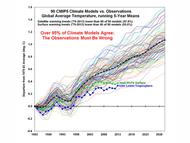Who Stole My Warming – Problems With the Models
- By:
- Edward A. Reid Jr.
- Posted On:
- Sep 12, 2017 at 6:32 AM
- Category
- Climate Change
“It doesn't matter how beautiful your theory is, it doesn't matter how smart you are. If it doesn't agree with experiment, it's wrong.” Richard P. Feynman
“Over 95% of climate models agree: the Observations must be wrong.” Roy Spencer
“Everything should be made as simple as possible, but not simpler.” Albert Einstein
A recent paper in Nature Geoscience by a gaggle of co-authors, including several well-known members of the consensed climate science community, analyzed “causes of differences in model and satellite tropospheric warming rates”.
Abstract
In the early twenty-first century, satellite-derived tropospheric warming trends were generally smaller than trends estimated from a large multi-model ensemble. Because observations and coupled model simulations do not have the same phasing of natural internal variability, such decadal differences in simulated and observed warming rates invariably occur. Here we analyse global-mean tropospheric temperatures from satellites and climate model simulations to examine whether warming rate differences over the satellite era can be explained by internal climate variability alone. We find that in the last two decades of the twentieth century, differences between modelled and observed tropospheric temperature trends are broadly consistent with internal variability. Over most of the early twenty-first century, however, model tropospheric warming is substantially larger than observed; warming rate differences are generally outside the range of trends arising from internal variability. The probability that multi-decadal internal variability fully explains the asymmetry between the late twentieth and early twenty-first century results is low (between zero and about 9%). It is also unlikely that this asymmetry is due to the combined effects of internal variability and a model error in climate sensitivity. We conclude that model overestimation of tropospheric warming in the early twenty-first century is partly due to systematic deficiencies in some of the post-2000 external forcings used in the model simulations.
The full paper is available from Nature Geoscience, but is behind a paywall, so it is not freely accessible.
The graphic below, form Dr. Roy Spencer, illustrates the situation discussed in the Abstract reproduced above.

Note that both the UAH Lower Troposphere and HadCRUT surface temperature trends begin diverging after 1998, the Hadcrut trend diverges more dramatically beginning in 2007. Dr. Spencer’s critique of an earlier Santer paper on the divergence is here.
It appears that the models were “fitted” to the “adjusted” surface anomalies through approximately 2000, though the authors do not state that this is the case. Beyond 2000, the “adjusted” surface temperature anomalies decline through 2012, then begin rising due to the effects of the 2015/2016 super El Nino.
The authors are careful to avoid use of the terms “hiatus” and “pause” in describing the measured temperature anomaly trends after 2000, even though the consensed climate science community has provided more than 60 potential explanations for the “hiatus”.
The abstract combined with the above graph make several very important points:
- modeled warming is greater than measured warming in all but 2 models;
- the difference between modeled warming and measured warming is very unlikely to be the result of natural variability in the climate alone, but is a clear indication that natural variability is at play;
- the difference between modeled warming and measured warming is also unlikely to be the result of only natural variability plus a model error in climate sensitivity; and,
- the difference between modeled warming and measured warming is most likely the result of a combination of natural variability, inaccurate climate sensitivity and inaccurate external forcings in the model simulations.
The clear conclusion is that the current climate models do not actually model the real climate. The authors acknowledge that this is likely the result of a combination of sensitivity and forcings errors in the model simulations. Numerous recent papers have suggested climate sensitivities near or below the lower end of the range of climate sensitivities identified by the IPCC. Also, Dr. Spencer has previously suggested that cloud forcing, assumed by the IPCC to be positive, is more likely negative. However, it is also likely that several aspects of climate, which are not well understood and therefore not included in the current models, are also at play in the differences between the measured and modeled anomalies.
A recent paper suggests that the “adjustments” to the near-surface temperature anomalies have increased their values by approximately 0.1oC. Were these “adjustments” to be reversed and the actual observed anomalies were used in the analysis, the gap between the modeled anomalies and the observed anomalies would widen from approximately 0.3oC to approximately 0.4oC.
It is also clear that the current model ensemble demonstrates no significant predictive ability; and, thus, should not form the basis for establishment of national or global climate policy. Further, it is clear that there is no “hockey stick” present in the temperature anomalies, which is interesting since Dr. Michael Mann is a co-author of the paper.
“Climate Science is the science of data that aren’t and models that don’t.” Ed Reid


